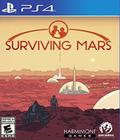Buy Surviving Mars
They say space is the final frontier, and Surviving Mars has us packing our bags for Martian exploration. Travels to space have been debated as a scientific possibility, and Mars has been the center of much discussion as a potential space colony. The red planet has been confirmed to have frozen water and could even support life due to its proximity to the sun. Being not too far away and just close enough, Mars provides a hopeful future for space settlement.
Surviving Mars takes those scientific possibilities and transforms them into a quaint, and surprisingly rich, building simulator. Starting out with only the bare minimum, players must construct their Martian colonies from scratch into bountiful utopias. Players start out with some drones and materials with the hope of creating a basic command center for the first batch of colonizers, or Founders, when they arrive.
Initially, the game leaves a hopeful impression with an optimistic soundtrack and bright visuals. Music that could be straight out of a science fiction movie creates a strong atmosphere for the game. The soundtrack provides a tranquil and optimistic tone as the backdrop for our construction and exploration. Visuals are rather detailed, as players can zoom into their colonies with the camera to see busy drones building away at your latest project and collecting resources found in the environment. The drones will serve as the maintenance crew throughout the game by making repairs and building infrastructure. A player with a desire for customization can even change worker drones' colors and rename them — as well as buildings and people — to their heart's content.
Camera controls provide all kinds of angles for players to observe their progress. The classic isometric view gives players an eagle's eye view of everything going on, but we are also able to zoom in at a ground level. Building and character models are detailed with vibrant colors and environmental effects. New infrastructure appears shiny and new with detailed textures. Over time, we are able to see how Mars' red dust accumulates on surfaces. These small details create a more immersive experience without seeming generic.
The details are more than just cosmetic, however, as dust can actually jam devices and cause malfunctions. The environmental effects can play a major role in how players manage their colonies. Do I push generators into overtime to produce more power for my structures at the risk of them accumulating dust more quickly? Should I land a rocket carrying supplies close to my base to cut the transportation time for my drones and suffer dust accumulation?
Dust can often be the least of a players' worries, however, as meteor showers can threaten productivity and damage buildings. Of course, there is also extreme heat and cold to be cautious about as well. These elements can cause worker drones to malfunction and even deteriorate colonists' health. Having to manage the upkeep of your citizens and technology is one of many facets of the game.
After players have built a suitable starting base, founders arrive to begin their new lives on Mars. The new colonists are expecting many of the same luxuries found on Earth. Luckily, there are quite a few different structures like casinos, diners and gyms to simulate their planet of origin. Players must also keep track of colonists' sanity and pleasurable experiences. The goal is to make Mars seem as appealing, if not more, than Earth. Colonists who are unhappy may jump ship on the next cargo shuttle to take off from Mars. It's important that players create a suitable environment for the first year or so, which is known as the Founder Stage. If all the colonists get Earth-sick and leave — or die from lack of resources — the game will end.
Success during the Founder Stage bodes well for players, since that means colonists will usually decide to stick around for the long haul. Any children born from Founders will never get Earth-sick and leave, since Mars is the only home they've known. From here, players can expand their colonies. Building domes to house life and advance technology provides deeper gameplay. There are dozens of research projects that yield various sci-fi technologies. There are even possibilities of making androids on Mars, if you're able to research that far. Not only must players build a productive and maintained community, but they'll also need to advance technology to unlock even greater rewards. The game may even require it in some cases, as players are able to control every aspect of their game — down to choosing a story scenario.
When starting a new map, players can choose their Commander Profile that guarantees benefits to the colony. There are 12 different profiles to choose from to fit various play styles. Going with a City Mayor profile, I was able to start with more funding from my mission sponsor and have some additional technology. It is also possible to choose sponsors that create difficulties for the game. Starting with a very easy sponsor adds more funding and grants more boons. The higher difficulty sponsors may even add drawbacks to gameplay, like slower resupply time. After making these decisions, players may even choose their own storylines and rules, with their own difficulties, to add more depth to the game. It can be said that Surviving Mars celebrates player freedom by providing a myriad of choices for different play styles.
Players wishing to just get the hang of the game even have the option of an Easy Start mode, which prefabricates a game with the easiest Mission Sponsor on easy maps. This allows for a mild first experience to get the feet wet. There is also a Creative mode that creates a game where buildings cost nothing and never malfunction, colonists never die or leave Mars, and base research is increased. This mode creates a stress-free environment for players who are simply looking to design their own Martian society. While environmental effects are still in place during Creative mode, there are no penalties to picking up where they left off.
For all of the game's creativity, it was unfortunate that gameplay could feel redundant. Since there are so many minute details in the game, it does require more patience. This can make gameplay feel slow at times, despite the ability to speed up time. The developers are still providing post-launch fixes and tweaks, but the game needs a little more flavor to avoid seeming generic. It has a good style and a rather addictive quality, but more compelling stories or more detailed exploration would be welcome. The game has players scanning areas of Mars to find resources and anomalies that may yield bonuses, but there are no major sights to explore beyond that. There isn't even the possibility of other life on Mars finding its way into the title. It's a little hard to believe that there are androids in this game, but not native Martians that we can interact with to build a joint society. The universe is vast, so why not play with those theories? The lack of identity leaves the game feeling like the same thing after a while. This did not keep me from building colonies for hours at a time, though!
Overall, Surviving Mars is a solid building simulator. Its numerous options for gameplay leave room for all kinds of play styles. Player choices maintain key roles in how they wish to shape their societies. A vast array of technology makes room for endless infrastructure combinations with a wonderful level of detail. A lack of content really brings down the game a few notches because the gameplay begins to feel repetitive after a while. Although the title has a lot of awesome details with science fiction flair, it doesn't bring any new surprises after a single playthrough. Whether players are seeking a challenging simulation or a chill Martian sandbox, Surviving Mars is a title that is worth a try.
Score: 7.0/10
More articles about Surviving Mars











 Surviving Mars is a management strategy game that challenges players to colonize the Red Planet.
Surviving Mars is a management strategy game that challenges players to colonize the Red Planet.























